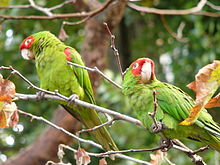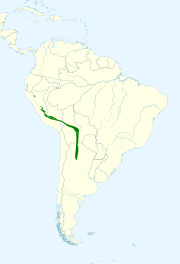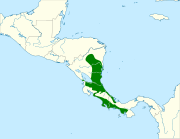Psittacara
| Psittacara | |
|---|---|

| |
| Red-masked parakeet (Psittacara erythrogenys), feral birds in a tree in California, United States | |
| Scientific classification | |
| Domain: | Eukaryota |
| Kingdom: | Animalia |
| Phylum: | Chordata |
| Class: | Aves |
| Order: | Psittaciformes |
| Family: | Psittacidae |
| Tribe: | Arini |
| Genus: | Psittacara Vigors, 1825 |
| Type species | |
| Psittacus gujanensis[1] Gmelin, JF, 1788
| |
| Species | |
|
See text. | |
Psittacara is a genus of parakeets in the tribe Arini. Species of the genus are found in Central and South America, the Caribbean and one species reaching the southern United States. Until 2013, all the species were placed in the genus Aratinga. Many of the Psittacara species are kept in aviculture or as companion parrots, where they are commonly known as conures.
Taxonomy
The members of this genus were formerly placed in the genus Aratinga. Molecular phylogenetic studies had found that Aratinga was non-monophyletic so in order to create monophylectic genera James Van Remsen Jr. and collaborators proposed in 2013 that Aratinga should be split and a group of species moved to the resurrected genus Psittacara.[2] The genus had been introduced in 1825 by the Irish zoologist Nicholas Aylward Vigors with the white-eyed parakeet as the type species.[3][4]
Species
The genus contains 13 species including one which is now extinct:[5]
| Common name | Scientific name and subspecies | Range | Size and ecology | IUCN status and estimated population |
|---|---|---|---|---|
| Green parakeet | Psittacara holochlorus (Sclater, PL, 1859) |
Mexico (Nuevo León and Tamaulipas south to Veracruz)
|
Size: Habitat: Diet: |
LC |
| Socorro parakeet | Psittacara brevipes (Lawrence, 1871) |
Socorro Island in the Revillagigedo Islands, Mexico[9] | Size: Habitat: Diet: |
|
| Red-throated parakeet | Psittacara rubritorquis (Sclater, PL, 1887) |
El Salvador, Guatemala, Honduras, and Nicaragua.[10] | Size: Habitat: Diet: |
LC
|
| Pacific parakeet | Psittacara strenuus (Ridgway, 1915) |
southern Mexico, Guatemala, El Salvador, Honduras, and Nicaragua.[6][8]
|
Size: Habitat: Diet: |
|
| Scarlet-fronted parakeet | Psittacara wagleri (GR Gray, 1845) Two subspecies[11]
|
Colombia and Venezuela.[6]
|
Size: Habitat: Diet: |
NT
|
| Cordilleran parakeet | Psittacara frontatus (Cabanis, 1846) |
Eucador's Loja Province and south through most of western Peru[6] | Size: Habitat: Diet: |
NT
|
| Mitred parakeet | Psittacara mitratus (Tschudi, 1844) |
Argentina, Bolivia, and Peru.[6]
|
Size: Habitat: Diet: |
LC
|
| Red-masked parakeet | Psittacara erythrogenys Lesson, 1844 |
Ecuador and Peru.[6]
|
Size: Habitat: Diet: |
NT
|
| Finsch's parakeet | Psittacara finschi (Salvin, 1871) |
Costa Rica, Nicaragua, and Panama[6]
|
Size: Habitat: Diet: |
LC
|
| White-eyed parakeet | Psittacara leucophthalmus (Müller, PLS, 1776) Three subspecies[14]
|
Trindad and from eastern Venezuela east through the Guianas and south through Brazil into Bolivia, Paraguay, northern Argentina, and Uruguay.[6]
|
Size: Habitat: Diet: |
LC
|
| Cuban parakeet | Psittacara euops (Wagler, 1832) |
Cuba[6]
|
Size: Habitat: Diet: |
VU
|
| Hispaniolan parakeet | Psittacara chloropterus Souancé, 1856 |
Dominican Republic and Haiti[6]
|
Size: Habitat: Diet: |
VU |
| † Puerto Rican parakeet
|
Psittacara maugei (Souancé, 1856) |
Mona Island | Size: Habitat: Diet: seeds, fruits, nuts and berries.[16] |
EX
|
Hypothetical species
- † Guadeloupe parakeet (Psittacara labati)
- Jean-Baptiste Labat described a population of small parrots living on Guadeloupe, which have been postulated to be a separate species based on little evidence. They were originally named Conurus labati, but no specimens or remains of these parrots exist. Their taxonomy may never be fully elucidated, and so their postulated status as a separate species is hypothetical.[17]
References
- ^ "Psittacidae". aviansystematics.org. The Trust for Avian Systematics. Retrieved 2023-07-24.
- ^ Remsen Jr., J.V.; Schirtzinger, E.E.; Ferraroni, A.; Silveira, L.; Wright, T. (2013). "DNA-sequence data require revision of the parrot genus Aratinga (Aves: Psittacidae)". Zootaxa. 3641 (3): 296–300. doi:10.11646/zootaxa.3641.3.9. PMID 26287088.
- ^ Vigors, Nicholas Aylward (1825). "Sketches in ornithology; or, Observations on the leading affinities of some of the more extensive groups of birds". Zoological Journal. 2: 37–70, 182–197, 368–405, 466-483 [388-389, 400].
- ^ Dickinson, E.C.; Remsen, J.V. Jr., eds. (2013). The Howard & Moore Complete Checklist of the Birds of the World. Vol. 1: Non-passerines (4th ed.). Eastbourne, UK: Aves Press. p. 368. ISBN 978-0-9568611-0-8.
- ^ Gill, Frank; Donsker, David; Rasmussen, Pamela, eds. (January 2021). "Parrots, cockatoos". IOC World Bird List Version 11.1. International Ornithologists' Union. Retrieved 3 July 2021.
- ^ a b c d e f g h i j k Gill, F.; Donsker, D.; Rasmussen, P., eds. (July 2023). "Parrots, cockatoos". IOC World Bird List. v 13.2. Retrieved July 31, 2023.
- ^ Chesser, R. T., S. M. Billerman, K. J. Burns, C. Cicero, J. L. Dunn, B. E. Hernández-Baños, R. A. Jiménez, A. W. Kratter, N. A. Mason, P. C. Rasmussen, J. V. Remsen, Jr., D. F. Stotz, and K. Winker. 2022. Check-list of North American Birds (online). American Ornithological Society. https://checklist.aou.org/taxa
- ^ a b BirdLife International (2018). "Green Parakeet Psittacara holochlorus". IUCN Red List of Threatened Species. 2018: e.T62296899A132190435. doi:10.2305/IUCN.UK.2018-2.RLTS.T62296899A132190435.en. Retrieved 6 April 2023.
- ^ Collar, N., G. M. Kirwan, C. J. Sharpe, and P. F. D. Boesman (2020). Socorro Parakeet (Psittacara brevipes), version 1.0. In Birds of the World (S. M. Billerman, B. K. Keeney, P. G. Rodewald, and T. S. Schulenberg, Editors). Cornell Lab of Ornithology, Ithaca, NY, USA. https://doi.org/10.2173/bow.grnpar2.01 retrieved April 5, 2023
- ^ BirdLife International (2016). "Red-throated Parakeet Psittacara rubritorquis". IUCN Red List of Threatened Species. 2016: e.T22729157A95008068. doi:10.2305/IUCN.UK.2016-3.RLTS.T22729157A95008068.en. Retrieved 5 April 2023.
- ^ R. Terry Chesser, Kevin J. Burns, Carla Cicero, Jon L. Dunn, Andrew W. Kratter, Irby J. Lovette, Pamela C. Rasmussen, J. V. Remsen, Jr., Douglas F. Stotz, and Kevin Winker. "Fifty-ninth supplement to the American Ornithological Society’s Check-list of North American Birds". The Auk 2019, vol. 136:1-23 retrieved April 5, 2023
- ^ HBW and BirdLife International (2022) Handbook of the Birds of the World and BirdLife International digital checklist of the birds of the world. Version 7. Available at: http://datazone.birdlife.org/userfiles/file/Species/Taxonomy/HBW-BirdLife_Checklist_v7_Dec22.zip retrieved December 13, 2022
- ^ Arndt, T. (2006). "A revision of the Aratinga mitrata complex, with the description of one new species, two new subspecies and species-level status of Aratinga alticola". Journal of Ornithology. 147 (1): 73–86.
- ^ Remsen, James V.; Urantówka, Adam (2013). "Divide Aratinga into four genera". AOS South American Classification Committee. Retrieved 5 April 2023.
- ^ BirdLife International (2020). "Hispaniolan Parakeet Psittacara chloropterus". IUCN Red List of Threatened Species. 2020: e.T22685695A179413764. doi:10.2305/IUCN.UK.2020-3.RLTS.T22685695A179413764.en. Retrieved 9 April 2023.
- ^ BirdLife International (2020). "Psittacara chloropterus". IUCN Red List of Threatened Species. 2020: e.T22685695A179413764. doi:10.2305/IUCN.UK.2020-3.RLTS.T22685695A179413764.en. Retrieved 18 November 2021.
- ^ Fuller, Errol (1987). Extinct Birds. Penguin Books (England). p. 131. ISBN 0-670-81787-2.











